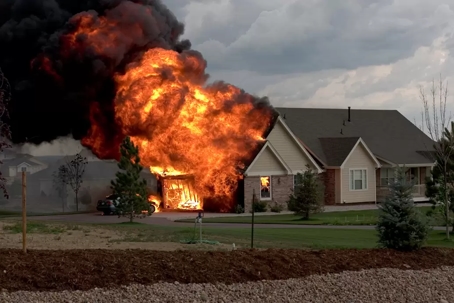Selecting the appropriate fire extinguisher isn't just about safety—it's about ensuring the longevity of your property and minimizing the need for costly fire restoration. As a fire restoration company, we understand the importance of making the right choice. In this article, we'll guide you through the process of choosing the right fire extinguisher for your specific needs, explaining different types, their uses, and the key considerations that should guide your decision.
Understanding of Fire Classes:
Let's dive deeper into the world of fire safety. Next on our agenda is a comprehensive understanding of fire classes. Knowing these classes is crucial in not only selecting the correct fire extinguisher but also in effectively reacting to different fire situations.
Class A - Ordinary Combustibles:
Fires involving ordinary combustibles such as wood, paper, and cloth fall under this category. Water extinguishers are effective for Class A fires and should be placed in areas where these materials are present, such as offices, living rooms, and bedrooms.
Class B - Flammable Liquids and Gases:
Class B fires involve flammable liquids and gasses, including gasoline and propane. Foam extinguishers create a barrier, preventing the vapors from igniting. Ideal for garages, workshops, and areas with chemical storage.
Class C - Electrical Fires:
Fires caused by electrical equipment fall into Class C. Carbon Dioxide (CO2) extinguishers are ideal for these fires as they displace oxygen, suppressing the fire without causing damage to electrical equipment. Place them near electrical panels, computer rooms, and other areas with electrical equipment.
Class D - Combustible Metals:
Class D fires involve combustible metals like magnesium and titanium. Specialized Class D extinguishers, using materials like sodium chloride or copper powder, should be placed in industrial settings where these metals are present.
Class K - Kitchen Fires:
Designed for fires involving cooking oils and fats, Class K extinguishers use a special wet chemical that reacts to form a soapy substance, extinguishing the fire and preventing re-ignition. Place them near stoves and cooking areas.
Types of Fire Extinguishers - Detailed Information:
Water Extinguishers:
Class Applicability: Class A fires (Ordinary Combustibles)
Usage: Suitable for materials like wood, paper, and cloth.
Ideal Locations: Offices, living rooms, bedrooms.
Foam Extinguishers:
Class Applicability: Class A and B fires (Ordinary Combustibles, Flammable Liquids, and Gases)
Usage: Effective against fires involving flammable liquids and gasses.
Ideal Locations: Garages, workshops, areas with chemical storage.
Carbon Dioxide (CO2) Extinguishers:
Class Applicability: Class B and C fires (Flammable Liquids and Gases, Electrical Fires)
Usage: Suitable for electrical fires and flammable liquids.
Ideal Locations: Near electrical panels, computer rooms.
Dry Chemical Extinguishers:
Class Applicability: Class A, B, and C fires (Ordinary Combustibles, Flammable Liquids and Gases, Electrical Fires)
Usage: Versatile and suitable for multiple fire classes.
Ideal Locations: Offices, workshops, industrial settings.
Class D Extinguishers:
Class Applicability: Class D fires (Combustible Metals)
Usage: Specifically designed for combustible metals.
Ideal Locations: Industrial settings with combustible metals.
Class K Extinguishers:
Class Applicability: Class K fires (Kitchen Fires - Cooking Oils and Fats)
Usage: Tailored for kitchen fires, preventing re-ignition.
Ideal Locations: Kitchens, both residential and commercial.
Fire Prevention and Hazard Awareness:
In the realm of home safety, fire prevention hinges on a heightened awareness of potential hazards. A thorough home inspection is a crucial step in identifying and mitigating fire risks. Understanding the placement of electrical wiring, checking the functionality of smoke detectors, and ensuring proper storage of flammable materials are essential aspects of home hazard awareness. By incorporating regular home inspections into one's routine, individuals can proactively address potential fire hazards and implement preventive measures. This proactive approach not only enhances the safety of the home environment but also underscores the significance of hazard awareness as an integral part of fire prevention strategies.
Extinguisher Selection Tips - Detailed Information:
Assess Fire Risks:
Identify potential fire risks in your environment, considering the materials present and the specific fire classes involved.
Size and Capacity:
Consider the size and capacity of the extinguisher based on the size of the area it needs to cover. Larger areas may require larger extinguishers or multiple units.
Accessibility:
Ensure that extinguishers are easily accessible and strategically placed in designated locations. Visibility and quick access are crucial during emergencies.
Multipurpose Extinguishers:
Opt for multipurpose extinguishers when applicable. These versatile extinguishers can handle multiple fire classes, providing a comprehensive solution.
Consider Location-specific Needs:
Different areas of your home or workplace may require specific types of fire extinguishers. Tailor your selection to the unique characteristics of each space.
Maintenance and Training:
Regularly maintain extinguishers to ensure they are in proper working condition. Additionally, provide training to individuals on proper extinguisher usage and evacuation procedures.
Portable Fire Suppression and Emergency Response:
Explore the portability of fire extinguishers and their role in emergency response. Having easily accessible extinguishers in designated locations can make a significant impact during emergencies.
Fire Extinguisher Guidelines and Maintenance:
Familiarize yourself with fire extinguisher guidelines and maintenance practices. Regular upkeep is crucial to ensuring that your fire extinguisher is in proper working condition.

Additional Considerations:
In conclusion, the process of selecting the right fire extinguisher is a critical aspect of comprehensive fire safety. By understanding the detailed descriptions of fire classes, considering maintenance tips, and aligning your choice with specific fire risks, you enhance your ability to respond effectively in case of a fire incident. Remember, fire safety is a multifaceted endeavor, and choosing the right extinguisher is just one part of the equation.
As we prioritize fire safety, it's equally important to extend our considerations beyond extinguishing flames. When contemplating construction or renovation projects for your future, ensure that the chosen construction company adheres to high-quality standards and incorporates all necessary fire safety requirements into their work. A thorough and diligent construction approach not only ensures the structural integrity of your property but also contributes significantly to its resilience against potential fire hazards. Make informed decisions, stay vigilant, and prioritize safety in every aspect of your endeavors. Your proactive approach today will undoubtedly contribute to a safer and more secure tomorrow.

